Attributing Daguerreotype Portraits from Bergen to Photographer Marcus Selmer

ABSTRACT
Danish pharmacist Marcus Selmer (1818-1900) arrived in Bergen, Norway in 1852 and became the town ́s first resident daguerreotypist. Although Selmer worked in Bergen for 48 years, his extant photographs number only in the hundreds, and only 14 Norwegian daguerreotypes are decisively attributed to him. It has long been suggested, by museum staff, archivists and researchers, that a significantly higher number of daguerreotypes extant today must be by Marcus Selmer. The Daguerreobase Project offered a rare opportunity to collect information on and digital images of daguerreotypes from different collections, and to systematically consider all the known daguerreotypes in Bergen simultaneously.
Here, we take one daguerreotype that has been positively attributed to Marcus Selmer as our starting point. We compare this image visually to other, unidentified plates in several museum collections. Through this investigation, we make the case that a considerable number of daguerreotypes in Bergen collections are by Selmer, and that they can be successfully identified by various objects belonging to the photographer and visible in the images. Marcus Selmer was a noted Bergen photographer, and the attribution of hitherto anonymous daguerreotypes to Selmer is thus of great value for Bergen ́s photographic history.
KEY WORDS_History of Photography, Marcus Selmer (1818-1900), daguerreotype portraiture, Norwegian daguerreotypes, attributing daguerreotypes
By MARTHE T. FJELLESTAD AND MORTEN HEISELBERG, University of Bergen Library, Norway. First published in Daguerreotype Journal Year 2 | Issue N.2 Spring 2015
INTRODUCTION
Marcus Selmer was the first permanent photographer in Bergen, Norway, starting out as a daguerreotypist in 1852. Although he worked in Bergen for 48 years, his extant photographs number only in the hundreds, and only 14 Norwegian daguerreotypes are decisively attributed to him. Here, we make the case that a much larger number of extant daguerreotypes in Bergen collections are by Selmer, and that they can be successfully identified by a number of objects belonging to the photographer and visible in the images. The paper starts with a short introduction to Selmer.
THE ARRIVAL OF THE PHOTOGRAPHING PHARMACIST
Marcus Selmer (1818-1900) was born in Randers, Denmark, on October 6th 1818. He received the degree of candidatus pharmacia
in 1838, and from 1842 managed his uncle’s chemist’s shop in Randers. This was only a temporary arrangement however, as the pharmacist position was ultimately intended for his cousin. Alongside his day job, Selmer started experimenting with the new invention of Daguerreotype and entering pictures in local exhibitions. A label on the back of a daguerreotype dating from 1850 and belonging to Randers Museum announces: “Selmer” Founder of the Daguerreotype in Randers alongside Master Painter Ludvig Us[s]ing.’’[1]

SELMER’S SUCCESS IN BERGEN
By all accounts, Marcus Selmer was the most prolific daguerreotypist in Bergen in the early to mid-1850s. From 1843 onwards, a number of photographers periodically visited the growing city,[3] most often arriving by ship during the summer and leaving again before sea traffic ceased for the winter season. The winter exodus wasmainlyduetothecity ́sadverseweather
conditions. Dark and wet, photographers struggled with a lack of light indoors and with rainy and cold conditions outside. Perhaps anticipating the summer competition, Selmer sought to turn the disadvantageous climate to his advantage when he bought a property and built and furnished a photographic atelier in 1854. Selmer constructed his studio predominantly of glass, which allowed him to take portraits throughout the year. Selmer thus became Bergen`s first permanent resident daguerreotypist.
It is clear that Selmer did very well as a photographer, and tax records from 1865 indicate that he was one of Bergen’s highest- earning men.[4] To maintain this position, Selmer had to keep up with the rapidly developing field, and from 1857 he stopped Daguerreotyping and took up paper photography. Largely
a portrait photographer, he also travelled regionally and produced a large number of city views, notably the earliest known view from Bergen, a Daguerreotype dated 1854. Today, Selmer is best known for his series of photographs documenting folk costumes from different regions, produced in various formats and sizes from daguerreotypes to stereo views and cabinet cards (Ill. 3 a-b).[5]
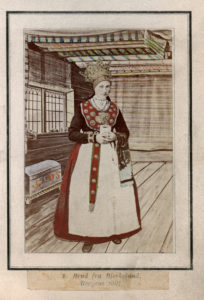

SELMER’S DAGUERREOTYPE PORTRAIT PLATES
Despite Selmer’s unquestionable presence in Bergen during the Daguerreotype era, only a very small number of extant plates are attributed to him today. Of the 234 plates found in various Bergen collections, only 12 are definitely Selmer’s, while a further five are presumed his. Additionally, two daguerreotypes at the National Library in Oslo are known to be by Selmer.[6] More than a reflection of the actual number of extant Selmer daguerreotypes, these numbers are the probable results of previous careful, maybe even restrictive, attribution routines and museum practices. Indeed, Roger Erlandsen’s extensive 1982 account of early photographers in Bergen attributed several other daguerreotypes to Selmer: of the ten plates he mentions specifically, only three correspond with the 14 decisively attributed daguerreotypes. Erlandsen suggested that around twenty daguerreotypes should be attributed to Selmer or his studio due to similar elements visible in these images.[7] Similarly, a number of archivists and historians have repeatedly commented on the distinct qualities inherent in portraits they believe to be by Selmer, such as the sitters ́ relaxed poses and facial expressions or the physical closeness and affection displayed by many sitters in group portraits. Another clue is the very high quality of the plates presumed to be Selmer ́s, with extreme image sharpness and few polishing marks. Despite such informal intuitions and much scholarly interest in Selmer, the relevant images have so far escaped positive identification as Selmer’s work.
VISUALLY IDENTIFYING SELMER’S PORTRAITS
Bergen’s collection of daguerreotypes exists across several different museum institutions and locations, as well as in private collections. The Europe-wide Daguerreobase Project offered a rare opportunity to systematically collect information on the extant daguerreotypes in Bergen, and to present information on and digital copies of the images.[8] This systematization of data has enabled us to for the first time consider all the known daguerreotypes in Bergen simultaneously. Scrolling down the list of images reveals differences and similarities in casings, poses, props and photographic quality. In the following, we will briefly investigate a number of daguerreotypes and make the case that the data now available in Daguerreobase can allow us to attribute, with a high degree of certainty, a large number of known daguerreotypes to Marcus Selmer.[9]
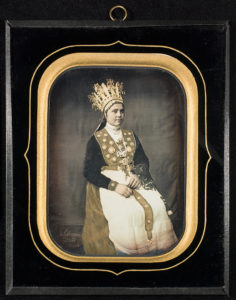

THE RECURRING TABLE CLOTH
Ill. 4a is one of nine known daguerreotypes in Marcus Selmer’s extensive folk costume series. It is a portrait of a woman seated in front of a curtain or a studio backdrop, wearing a traditional bridal outfit. The image has hand- colored details, specifically on the woman’s skirt, bodice insert and belt decorations. She wears an ornate golden crown and multiple golden brooches, also hand-colored. A piece of patterned fabric drapes innocuously over one of her arms and she holds something – a handkerchief? – in one hand. This is one of the twelve daguerreotypes positively attributed to Marcus Selmer in Bergen. Several factors aid this attribution; the plate is signed “Selmer 1855 Bergen” in the bottom left, the motif corresponds with Selmer’s project of photographing regional costumes, and the plate was a personal gift from Selmer to the Vestlandske Kunstindustrimuseum before his death.[10]
Much could be said about this image – about the sitter’s pose and expression, the details of her costume, or about Selmer’s contribution to the wider project of documenting and distributing traditional Norwegian customs and costumes at home and abroad. In the context of visual identification however, the most interesting detail in this portrait is the fabric draped over the woman’s arm and across her lap (Ill. 4b). Its pattern is identical to that of a table cloth visible in a large number of unidentified daguerreotypes from Bergen.
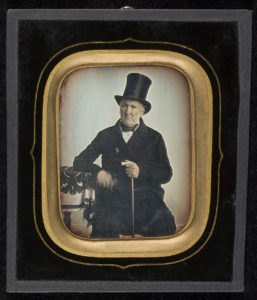
One particularly interesting example comes from the Bergen City Museum. Ill. 5 depicts Fredrik Meltzer (1779-1855), a signatory to the Norwegian Constitution of 1814 and designer of the Norwegian flag. Meltzer was one of Bergen’s elite, and it is hardly a stretch to presume that Selmer, as Bergen’s foremost photographer, both knew Meltzer and would have celebrated the opportunity to take his photograph. When he had this portrait taken, Meltzer was an elderly man, noticeable in the image by the blur caused by his shaking hand. Dressed in a top hat and holding a walking stick, he sits in a studio environment, leaning the elbow of his shaking arm on a small table covered with a table cloth. A large area of the table cloth is visible, more than enough to confirm that its pattern is compatible with the cloth featured in the previous image.
The fabric or table cloth is more likely than not one of Selmer’s studio props, and one of several items that can help us identify his images. Although one should be careful not to make rash, and potentially false, conclusions, the recurrence of this table cloth in a large number of otherwise very visually similar daguerreotypes strongly points towards the same photographer or studio.[11]
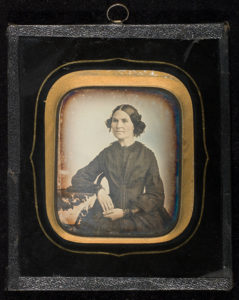
Once we attribute a daguerreotype to Selmer, other connections can be made with yet other daguerreotypes. We will follow the table cloth to one last image, this time in a portrait of Mrs. Laura Hagelsteen (1814-1889) (Ill. 6). Like Meltzer, she leans an elbow on a table with the now familiar table cloth, helping stabilize her body for the time it took to take the photograph.
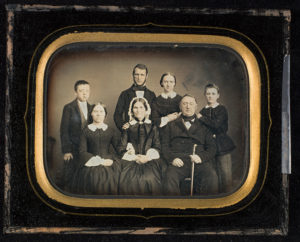
Pictured aged around 40, Hagelsteen’s upright posture and solemn yet calm expression testifies to the special occasion it still was to have one’s portrait taken. However, we find evidence in the Daguerreobase that visiting the photographer’s studio was becoming more common. The Hagelsteen family had portraits and group portraits made on a number of occasions, and at least some of them still exist. In Ill. 7, Laura Hagelsteen is surrounded by family members, including her husband, two sons and a sister. It is very possible that the family came back to Selmer on several occasions, and that at least some of the unidentified images of this family were made by him. Similar connections can be made between Selmer and a number of prominent Bergen families all of whom at one point had a portrait taken featuring Selmer ́s table cloth.
CONCLUSION
As the above examples testify, it is possible to identify and likely attribute daguerreotypes
made by specific photographers or photographic studios based on objects that make repeated appearances in daguerreotype images. In the case of Marcus Selmer, such objects include the table cloth discussed here, as well as one or more chairs and at least one patterned carpet. Some of these objects appear both in Selmer ́s daguerreotypes and in his later paper photographs, enabling us to connect newer photographic prints with the relatively small number of extant daguerreotypes.
Despite Marcus Selmer ́s position as a noted Bergen photographer, few of his images are known today. The attribution of anonymous daguerreotypes to Selmer opens up further avenues for research and scholarship based on his work, and is in itself of great value for Bergen ́s photographic history.
BERGEN INSTITUTIONS PARTICIPATING IN THE DAGUERREO- BASE PROJECT INCLUDE:
-
- Bergen City Museum (Old Bergen Museum and Alvøen Manor)
- The Picture Collection, University Library of Bergen, University of Bergen
- The Photograohy Archive at the University Museum, University of Bergen
_______________________________________
NOTES
[1]. Bjørn Ochsner. Fotografer i og fra Danmark indtil år 1900. 2nd ed. København: Det Kongelige Bibliotek, 1969, p. 482.
[2]. Marcus Selmer. Daguerreotyp-Portraiter! in Bergen Adressecontoir, September 11th, 1852. See Ill. 1.
[3]. Roger Seeman Erlandsen. Frå kunstnar til handverkar. Fotografene i Bergen 1840-65. Part I: Text. Hovedfagsoppgave i historie, Bergen: UiB, 1982, p. 53.
[4]. Ibid., p. 166.
[5]. These images form part of a larger nation-building project that from the mid-1800s saw traditional Norwegian customs, costumes, fairy-tales and dialects enter the national consciousness through paintings, poetry and, like here, through photography.
[6]. Of 14 known Selmer daguerreotypes, 13 are currently registered in Daguerreobase.
[7]. Erlandsen, Frå kunstnar til handverkar, p. 98.
[8]. Digitization of the daguerreotypes as well as project management and administration took place at the Picture Collection at the University Library of Bergen on behalf of the participating institutions in the region.
[9]. The authors would like to stress that a more thorough investigation involving the various museum ́s records and databases, as well as the daguerreotypes themselves, will have to be conducted in order to verify the results described in this paper.
[10]. Private communication with Collection Manager Laila Lundberg Søreide at KODE Art Museums of Bergen, January 2015.
[11]. It is not known whether Selmer employed other daguerreotypists in his studio in the mid-1850s, however the stiff competition of these years suggests he had to concentrate on establishing a market. In later years he employed photographers and apprentices.